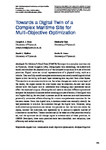Towards a Digital Twin of a Complex Maritime Site for Multi-Objective Optimization
| dc.contributor.author | Ross, Joseph | |
| dc.contributor.author | Walker, David | |
| dc.contributor.author | Tam, Kimberly | |
| dc.contributor.author | Jones, Kevin | |
| dc.contributor.other | Faculty of Science & Engineering | en_US |
| dc.date.accessioned | 2022-06-06T14:43:02Z | |
| dc.date.available | 2022-06-06T14:43:02Z | |
| dc.date.issued | 2022-06-01 | |
| dc.identifier.uri | http://hdl.handle.net/10026.1/19279 | |
| dc.description.abstract |
Her Majesty's Naval Base (HMNB) Devonport is a complex maritime site in Plymouth, United Kingdom (UK). Using digital twin technology, the authors will model and simulate the physical entity of the dockyard to optimize for a set of critical priorities. Digital twins are virtual representations of a physical entity, such as a vehicle. They can fully model a complex environment, accurately modelling individual layers within the entity, with each layer accessing data required from other layers. This results in an accurate simulation so that when changes are made in one layer of the model, the impact across the other layers may be observed. An end-user could interact with this digital twin to understand how changing input parameters would affect the measured outputs, allowing the end-users to simulate different options and compare the simulated outcomes before deciding a course of action. If the digital twin is of higher fidelity, the simulated outcomes would be more accurate and demonstrate potentially unintended effects allowing for a more comprehensive overview for the decision-maker. From this digital twin, a decision-maker can manually identify the best parameters to simulate the outcomes through the digital twin. However, using multi-objective optimization can reduce this process so that the twin can create the inputs, monitor the outcomes, and repeatedly try to produce a specific number of outcomes to choose from. These outcomes would be based on a few priorities initially set, and the optimizer would change inputs to enhance each of these priorities. At HMNB Devonport, three main priorities have been identified: cost reduction, time efficiency and carbon neutrality. | en_US |
| dc.language.iso | en | |
| dc.publisher | University of Plymouth | en |
| dc.rights | Attribution-NonCommercial-NoDerivs 3.0 United States | * |
| dc.rights.uri | http://creativecommons.org/licenses/by-nc-nd/3.0/us/ | * |
| dc.subject | digital twin | en_US |
| dc.subject | visualization | en_US |
| dc.subject | multi-objective optimization | en_US |
| dc.subject | dockyard logistics | en_US |
| dc.title | Towards a Digital Twin of a Complex Maritime Site for Multi-Objective Optimization | en_US |
| dc.type | Article | en_US |
| plymouth.date-start | 2021-2022 | en_US |
| rioxxterms.funder | Ministry of Defence | en_US |
| rioxxterms.identifier.project | Royal Navy PhD Studentship | en_US |



